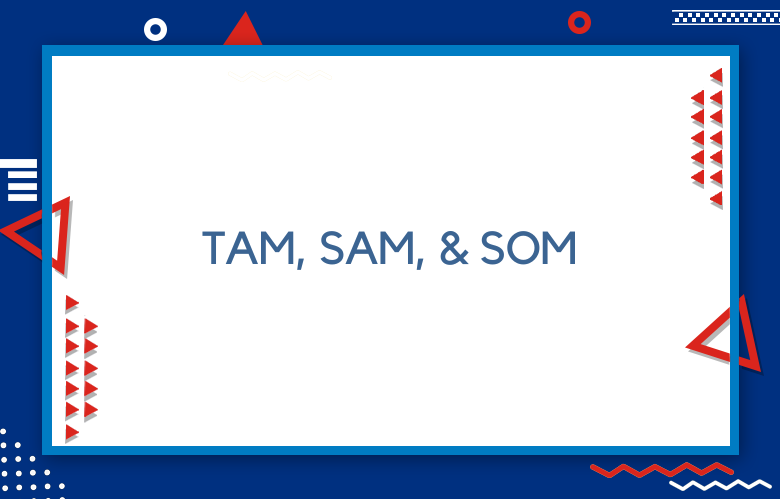TAM, SAM, & SOM: An Advanced Guide for Marketers

Understanding the Total Addressable Market (TAM), Serviceable Available Market (SAM), and Serviceable Obtainable Market (SOM) is crucial for marketers looking to assess market opportunities, set realistic goals, and develop effective strategies.
These market size metrics help businesses plan their growth strategies, allocate resources effectively, and secure investment by demonstrating market potential.
Misjudging your market in a high-stakes business can lead to catastrophic outcomes, such as overextended resources, missed targets, and investor disillusionment.
Consider the cautionary tale of a tech startup that burned through 10M in funding by targeting 10M of the financing by targeting a 50B market without realizing their actual obtainable share was a mere 0.1%. This is where TAM, SAM, and SOM transform from academic acronyms into survival tools.
These metrics empower businesses to navigate market realities with surgical precision, turning abstract potential into actionable strategy. Let’s dissect how these frameworks separate market daydreams from achievable victories.
Decoding the Trinity: TAM, SAM, SOM
TAM (Total Addressable Market)
TAM represents the total demand for a product or service, assuming no competition, geography, or pricing constraints. In an ideal scenario, it is a business’s maximum revenue potential.
The Ultimate Horizon
- Definition: The total revenue opportunity if you achieved 100% market dominance in your category.
- Analogy: The entire ocean of potential demand. For a SaaS company offering project management tools, this might be every organization globally that manages team workflows.
- Strategic Role: Answers “What’s the ceiling if everything goes perfectly?” This is critical for a long-term vision and attracting growth-focused investors.
SAM (Serviceable Available Market)
SAM is the segment of the TAM that a business can realistically target based on factors like geographical reach, product fit, and distribution channels.
The Strategic Battleground
- Definition: The portion of TAM you can realistically target with current capabilities.
- Key Filters: Geography (e.g., Southeast Asia vs. global), product fit (enterprise vs. SMB), regulatory constraints.
- Example: A premium electric scooter manufacturer might limit SAM to urban professionals in 15 high-income cities versus the global TAM of all commuters.
SOM (Serviceable Obtainable Market)
SOM is the share of the SAM that a company can realistically capture in the near term, considering competition, brand positioning, and marketing capabilities.
The Beachhead
- Definition: The market share you can realistically capture in 12-18 months.
- Critical Factors: Competitive intensity, sales cycle length, operational capacity.
- Hard Truth: Even dominant players rarely initially capture >30% of SAM.
Importance of TAM, SAM, and SOM
Understanding Market Potential
- It helps businesses estimate the maximum revenue opportunity (TAM).
- Identifies market segments a business can realistically target (SAM).
- Assists in setting achievable sales targets (SOM).
Strategic Business Planning
- Guides product development and expansion plans.
- It helps businesses allocate resources effectively.
- Assists in pricing and go-to-market strategies.
Investor Perspective
- Investors use TAM, SAM, and SOM to assess a company’s growth potential.
- Helps in securing funding by demonstrating realistic market opportunities.
Competitive Positioning
- Allows businesses to identify competition and potential market share.
- Helps in elaborating marketing and sales strategies to maximize reach.
How to Calculate TAM, SAM, and SOM
Calculating TAM
TAM is estimated using:
- Top-down approach: Uses industry reports and market research to estimate the total market size.
- Bottom-up approach: Multiplies the total number of potential customers by the average revenue per customer.
- Value-theory approach: Estimates the market size based on how much value the product provides.
Calculating SAM
SAM is derived from TAM by applying filters such as:
- Geographical limitations.
- Target customer demographics.
- Industry-specific constraints.
Calculating SOM
SOM is a realistic estimation based on the following:
- Company’s competitive advantage.
- Market penetration strategies.
- Expected customer conversion rates.
Formula Example:
- TAM = Total number of customers × Average revenue per customer.
- SAM = TAM × Percentage of the market a company can realistically target.
- SOM = SAM × Expected market share.
Applying TAM, SAM, and SOM in Business Strategy
Identifying Growth Opportunities
- TAM helps businesses evaluate long-term growth potential.
- SAM focuses on immediate revenue opportunities.
- SOM sets realistic short-term sales and marketing targets.
Optimizing Marketing & Sales Strategies
- Target high-value market segments based on SAM.
- Focus resources on achievable short-term revenue through SOM.
Expanding into New Markets
- TAM assessment helps businesses decide whether to expand.
- SAM ensures that expansion is feasible.
- SOM provides a roadmap for penetration strategies.
Common Pitfalls When Estimating TAM, SAM, & SOM
Overestimating Market Size
- Overly optimistic estimates can lead to unrealistic goals.
- Companies must validate assumptions with primary research.
Ignoring Competition
- Failure to assess competitors’ market share can skew SOM estimates.
- Competitive analysis is crucial in refining SAM and SOM.
Relying Only on Secondary Research
- Industry reports may not always reflect real-world market conditions.
- Use primary data such as surveys and sales insights to validate findings.
Static Market Estimates
- Market conditions change over time due to new competitors, economic shifts, and changes in customer behavior.
- Reassess TAM, SAM, and SOM periodically.
Why This Trio Outperforms Traditional Market Research
Traditional market studies often drown decision-makers in generic data—consumer sentiment surveys, trend reports, and competitive landscapes. TAM/SAM/SOM cuts through the noise with ruthless quantification:
Precision Targeting:
-
- Traditional: “Millennials prefer sustainable brands.”
- TAM/SAM: “12.4M urban millennials in Tier 1 cities will pay 15% premium for eco-friendly apparel—$3.7B SAM.”
Dynamic Adaptation:
-
- While traditional reports gather dust, these metrics evolve with your strategy. Entering Brazil? Recalculate SAM with local disposable income data.
Investor-Grade Clarity:
-
- VCs don’t fund “huge markets”—they fund achievable paths to dominance. A 500M SOM with 20% YoY capture demonstrates scalability.
Calculation Warfare: Top-Down vs. Bottom-Up
Top-Down Approach
- Uses broad market estimates from reports.
- Quick but prone to overestimation.
- Best for initial market sizing.
The Satellite View
- Method: Start with macro data (industry reports, GDP figures), then apply filters.
- Example:
- TAM: Global smart home market = $135B (Grand View Research)
- SAM: Security-focused products in EU+NA = 135B×40135B×4054B
- SOM: Your IoT startup’s 1st-year EU focus = 54B×354B×31.62B
- Pros: Fast, leverages existing data.
- Cons: Risk of “spreadsheet delusion”—assuming your tiny team can grab 3% of a fragmented $54B market.
Bottom-Up Approach
- Builds from actual customer data and sales figures.
- It’s more accurate but time-intensive.
- Best for revenue forecasting and detailed planning.
The Ground Truth
- Method: Build from unit economics upward.
- Example:
- SOM: 50 enterprise sales/year × 250KACV=250KACV=12.5M
- SAM: 2,000 target enterprises × 250K=250K=500M
- TAM: All 20,000 global enterprises × 250K=250K=5B
- Pros: Reality-checked by actual sales capacity.
- Cons: Labor-intensive; requires deep customer insight.
Pro Tip: Blended Approach = Satellite + Ground Recon. Use top-down for investor decks and bottom-up for operational planning.
Choosing the Right Approach
- Use top-down for market potential evaluation.
- Use bottom-up for detailed business planning.
- Combining both approaches provides the most reliable estimates.
Role of Competitive Analysis
Refining SOM Estimates
- It helps businesses gauge realistic market share within SAM.
- Identifies competitive strengths and weaknesses.
Strategic Positioning
- Guides marketing, pricing, and sales strategies.
- Identifies underserved market segments for better targeting.
Market Entry & Expansion
- TAM helps identify potential growth markets.
- SAM ensures feasible expansion plans.
- SOM provides realistic revenue projections for new markets.
Case Studies: Successful Applications of TAM, SAM, & SOM
SaaS Company Expansion
- TAM: Global enterprise software market.
- SAM: Businesses using CRM solutions.
- SOM: Mid-sized businesses in North America.
E-commerce Business Scaling
- TAM: Global online retail market.
- SAM: Fashion and accessories e-commerce.
- SOM: Urban millennials in the U.S.
Fast-Food Chain Growth
- TAM: Total fast-food industry revenue.
- SAM: Quick-service restaurants in a specific region.
- SOM: Percentage of local market captured through marketing efforts.
How Often Should You Reassess TAM, SAM, & SOM?
Regular Updates
- Quarterly or yearly reassessment based on market shifts.
- Ensures alignment with new competitors and consumer trends.
Major Business Changes
- When launching new products or services.
- When expanding into new geographical regions.
Industry Disruptions
- Technological advancements.
- Regulatory changes.
- Shifts in consumer behavior.
Pitfalls That Derail Even Seasoned Marketers
“If We Get Just 1%…” Fallacy
- Trap: Assuming linear scaling in non-linear markets. Getting 1% of a $100B TAM requires beating 50+ competitors.
- Fix: Model SOM using Porter’s Five Forces—what unique wedge lets you steal share?
Static Market Syndrome
- Trap: Treating TAM as fixed when disruptors reshape markets overnight (e.g., COVID-19 accelerating e-commerce TAM).
- Fix: Build scenario plans—how does your SAM shift if remote work grows 30%?
Ostrich Competitor Analysis
- Trap: Calculating SOM without mapping rivals’ CAPEX and customer lock-ins.
- Fix: War-game competitors’ responses—will incumbents slash prices if you gain a 5% share?
From Theory to Trenches: Operationalizing the Metrics
Phase 1: Resource Allocation
- SOM-First Budgeting: Allocate 70% of marketing spend to SOM conquest (proven converts), 20% to SAM expansion (adjacent segments), and 10% to TAM experiments (blue oceans).
Phase 2: Product Roadmaps
- SAM-Driven Features: If your SAM is a mid-market retailer, prioritize integrations with Shopify vs. SAP.
Phase 3: Talent Strategy
- TAM Hires: Future-focused roles (AI researchers for a pharma TAM play).
- SAM/SOM Hires: Vertical experts (e.g., ex-retail CROs for your current SAM).
The Reassessment Rhythm
Quarterly: Refresh SOM with the latest win/loss data.
Biannually: Re-evaluate SAM for market shifts (new regulations, tech breakthroughs).
Annually: Pressure-test TAM assumptions—is blockchain still adding $5B to your fintech TAM?
Tools & Software for TAM, SAM, & SOM Analysis
- Industry Reports: Gartner, Forrester, IBISWorld.
- Market Research Tools: Statista, Nielsen, SEMrush.
- Competitive Analysis Tools: SimilarWeb, Ahrefs.
- Financial Reports: SEC filings, investor presentations.
Tool Stack:
- TAM: Statista, Gartner, IBISWorld
- SAM: ZoomInfo (account-level sizing), Census data
- SOM: Gong/Pramata (deal analytics), Competitor benchmarking via Similarweb/Crunchbase
Conclusion: From Market Maps to Victory
TAM, SAM, and SOM are essential tools for marketers to estimate market potential, refine strategies, and make informed business decisions. By leveraging qualitative and quantitative approaches, businesses can position themselves for sustainable growth, secure investments, and gain a competitive edge in their industry.
TAM/SAM/SOM isn’t about spreadsheets but strategic discipline. By ruthlessly quantifying where you can win now (SOM), where you must build to win next (SAM), and what’s possible with breakthrough innovation (TAM), these metrics become the compass for sustainable dominance. The market doesn’t reward those who see the enormous pie; it rewards those who know precisely which slice they can take—and how to defend it.
Next Steps:
- Audit last year’s SAM assumptions vs. actuals—where were you off by >20%?
- Run a bottom-up SOM calculation using your latest sales cycle data.
- Book a wargaming session: What three competitors could block your SOM?
Ultimately, markets are conquered not by dreams of total domination but by mathematical rigor married to strategic audacity. TAM, SAM, and SOM are your equations for victory.



